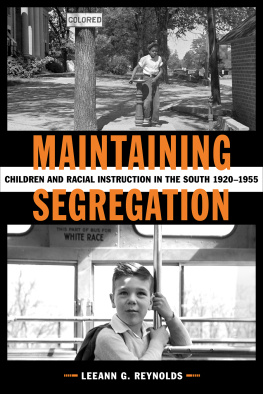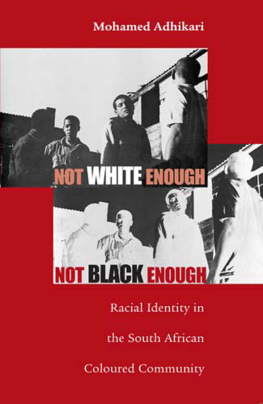2006 The University of North Carolina Press
All rights reserved
Manufactured in the United States of America
Set in Scala and Emma Script by Tseng Information Systems, Inc.
The paper in this book meets the guidelines for permanence and durability of the Committee on Production Guidelines for Book Longevity of the Council on Library Resources.
Publication of this book was supported in part by a generous gift from Eric Papenfuse and Catherine Lawrence.
Library of Congress Cataloging-in-Publication Data
Ritterhouse, Jennifer Lynn.
Growing up Jim Crow : how Black and White southern children
learned race / Jennifer Ritterhouse.
p. cm.
Includes bibliographical references and index.
ISBN-13: 978-0-8078-3016-1 (cloth : alk. paper)
ISBN-10: 0-8078-3016-x (cloth : alk. paper)
ISBN-13: 978-0-8078-5684-0 (pbk. : alk. paper)
ISBN-10: 0-8078-5684-3 (pbk. : alk. paper)
1. African AmericansSegregationSouthern StatesHistory20th century. 2. Southern StatesRace relationsHistory20th century. 3. Race awareness in childrenSouthern StatesHistory20th century. 4. African American childrenSouthern StatesSocial conditions20th century. 5. Children, WhiteSouthern StatesSocial conditions20th century. 6 . African AmericansRace identitySouthern States History20th century. 7. WhitesRace identitySouthern States History20th century. 8. EtiquetteSouthern StatesPsychological aspectsHistory20th century. I. Title.
E185.61.R59 2006
305.89607307509041dc22 2005035087
cloth 10 09 08 07 06 5 4 3 2 1
paper 10 09 08 07 06 5 4 3 2 1
Illustrations
Plantation owner with black child, Aldridge Plantation, Mississippi, June 1937
Lynching of Reuben Stacey, Fort Lauderdale, Florida, July 19, 1935
Illustration from the Crisis, October 1916
Children at Hill House, Mississippi, July 4, 1936
Boys wrestling by the side of the road, Person County, North Carolina, July 1939
Dorothy Gary Markey and her brother Barham Gary, 1908
Boy selling the Washington Daily News, November 8, 1921
High school boys on election day, Granville County, North Carolina, May 1940
Illustrations from Floyds Flowers, 1905
Children in the Silent Protest Parade, Harlem, July 28, 1917
Acknowledgments
My debts in this project are many and long-standing. For more than a decade (indeed, a solid third of my life), Jacquelyn Hall has guided my work and helped me to know myself and see who I want to be. I am grateful for her friendship, her steadfast support, the countless hours she has devoted to this and all of my projects, and the inspiring example she so gracefully sets in her own work and being.
I am also indebted to three other mentors, John Kasson, Suzanne Lebsock, and Anne Scott, each of whom has contributed a great deal to my intellectual development, and to a wide circle of friends and colleagues from my graduate school days in Chapel Hill and beyond. Jim Leloudis, Joel Williamson, and Reginald Hildebrand served on my dissertation committee and offered advice and encouragement. Soyini Madison guided me to theoretical readings and was a source of support early on. Many others in the Chapel Hill community, notably Judith Bennett, Stacy Braukman, Gavin Campbell, Peter Coclanis, Peter Filene, Natalie Fousekis, Pamela Grundy, Sandra Hayslette, Jerma Jackson, Joy Kasson, Don Mathews, John McGowan, Beth Millwood, Theda Perdue, and Molly Rozum, suggested readings, provided insights, read chapters, helped with references, or kept my spirits up at various times. G. C. Waldrep has also been a faithful friend and thoughtful reader early and late in this projects development.
Down the road from Chapel Hill, at Duke University, I found other sources of enlightenment and support, particularly through my work on Remembering Jim Crow. I enjoyed collaborating with and learned a lot from Bill Chafe, Raymond Gavins, Bob Korstad, Paul Ortiz, Robert Parrish, Keisha Roberts, and Nicole Waligora-Davis. I am also glad to think that Growing Up Jim Crow allows more voices from the Behind the Veil oral history collection to be heard.
When I reached the dissertation stage and moved to Philadelphia to live with my husband, Drew Faust was my anchor to southern history, and she and Sheldon Hackney kindly allowed me to sit in on a graduate seminar. Drew also introduced me to Kirsten Wood, who became a good friend and colleague. Kirsten helped organize a dissertation group that proved invaluable for both the insights and the emotional support it provided. Thanks to her and to the groups other members: Jason McGill, Allison Sneider, and Serena Zabin. Beth Clement participated in the group as well and continues to be a valued friend here in Utah. Leigh Edwards is another friend who made my time in Philadelphia enjoyable, as well as productive, and Susan Matt and Marjukka Ollilainen have played that role in my life since I moved west.
My colleagues at Utah State have supported this project in a number of ways, not least by letting me rearrange my teaching schedule and devote time to research and writing. I particularly appreciate the efforts of my department head, Norm Jones, to make my workload manageable. I also value the advice and encouragement I have received from Mick Nicholls and the other members of my tenure and promotion committee: Melody Graulich, David Rich Lewis, Dan Mclnerney, and Fran Titchener. The fact that my department gave me a surprise baby shower before my daughter Sophie was born is just one indication of what a friendly and nurturing place the USU History Department is. Three members of the department who have since moved on, Anne Butler, Clyde Milner, and Carol OConnor, embody that spirit of warmth as well, and I appreciate the support that each of them gave me in my first couple of years of teaching.
I have benefited from the insights and advice of a number of scholars who commented on conference papers or otherwise took time to discuss my work. I learned a lot from Karen and Barbara Fields in the course of a shuttle bus ride in Charleston, and Paula Giddings and Nell Painter each offered helpful suggestions in the course of chance conversations as well. John Kasson, Jane Dailey, Patrick Ryan, Fitzhugh Brundage, Nancy Hewitt, Anne Scott, Elsa Barkley Brown, Eileen Boris, Glenda Gilmore, and Edward D. C. Campbell all commented on papers at various conferences, workshops, and symposia. Cliff Kuhn, Rebecca de Schweinitz, and Diana Selig offered suggestions more informally, but no less helpfully. Sandra Treadway, Nancy Essig, and Ted Ownby have all helped me feel my work was important. I also want to thank Vincent Cheng and the other participants in a works-in-progress group at the Tanner Humanities Center, where I spent a final year revising the manuscript: Nadja Durbach, Marian Eide, Dan Greenwood, David Hawkins, Joe Metz, Ronald Smelser, and Carolina Webber. Thanks, too, to Holly Campbell and Beth Tracy for their work keeping the Tanner Center running smoothly.
Throughout my research for this project, librarians and archivists have helped with innumerable questions, large and small. I particularly want to thank John White of the Southern Historical Collection at the University of North Carolina at Chapel Hill and Randall Burkett of the Woodruff Library at Emory University, as well as staff members at those two institutions and at the University of Georgia, the Atlanta History Center, the Atlanta University Center, the Georgia Department of Archives and History, the University of Virginia, the Schomburg Center for Research in Black Culture, and the Rockefeller Archive Center. Thanks also to my two research assistants, Jennifer Hodgkinson and Jennifer Holland.





